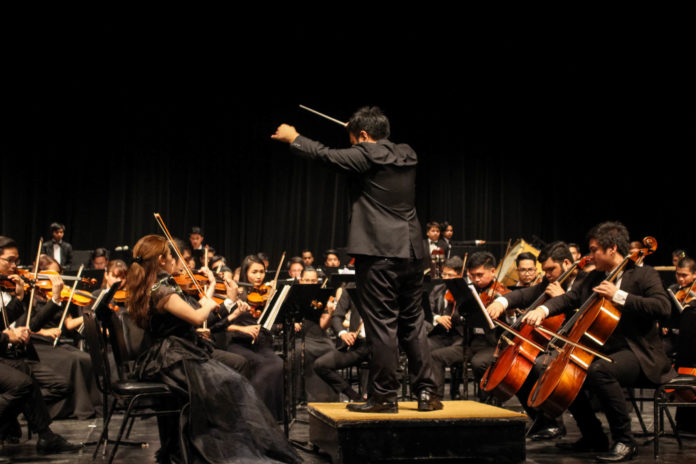A CONDUCTING student of the Conservatory of Music dedicated his graduation recital at the Tanghalang Aurelio Tolentino (Little Theater) of the Cultural Center of the Philippines (CCP) last May 12 to his mother and played all her favorites.
The concert was held on the eve of Mother’s Day. Jedrick Itugot, who was graduating with a Bachelor of Music degree in Orchestral Conducting, led the UST Symphony Orchestra in playing opera classics.
He might have had a full house, but Itugot only had his mother in his mind.
“This recital is actually for my mother,” Itugot said. “It’s my way of thanking her because I wouldn’t have had my recital at CCP if it weren’t for her and my dad.”
Joining Itugot was fellow senior and Voice major Angella Lista who gave a soulful rendition of the conductor’s arrangement of his mom’s all- time favorite—Wency Cornejo’s “Hanggang.”
Lista also sang Antonio Lucio Vivaldi’s “Motet in Furore Iustissimae Irae, Rv 626” and Wolfgang Amadeus Mozart’s “E Susanna Non Vien… Dove Sono.”
“Motet in Furore” saw only the string instruments at play. The repetitive piece describes a man’s plea for mercy after having displeased God with his misdeeds.
Dark foreboding filled the theater when the orchestra played “E Susanna Non Vien,” which deals with a couple’s broken marriage.
The night’s repertoire also included Russian composer Pyotr Ilyich Tchaikovsky’s “Romeo and Juliet Overture Fantasy.” The piece recounted scenes from William Shakespeare’s classic drama, beginning with the introduction of Friar Laurence rendered in F minor.
Retelling the heated match between the Capulets and Montagues, the piece shifted to B minor accompanied by clashing cymbals and quick 16th notes. Although the song slowed down a little with the recounting of the young lovers’ courtship, the loud battling sound resumed when Rome and Juliet consummated in suicide, building up gradually and continuing all the way to the end.
Following the Tchaikovsky piece was Russian composer Dmitri Shostakovich’s “Symphony No. 5 in D Minor, Op. 47,” the most debated classical piece in terms of song meaning.
A four-movement piece, “Symphony No. 5” infused all of the sections of the orchestra with some parts relying heavily on string instruments, wind instruments, harp-violin-cello trio and strings-flute-bassoon trio.
Opening the second half of “Symphony No. 5” was a soothing melody from the violin group, succeeded by separate flute and oboe solos.
The piece ended with a marching section intensified by the trumpets
and horns.
A student of Assoc. Prof. Herminigildo Ranera, Itugot has conducted several performances of the UST Symphony Orchestra, UST Wind Orchestra, and UST Woodwind Ensemble. He
has also arranged numerous pieces for the Philippine Philharmonic Orchestra.
Among Itugot’s notable arrangements is “Symphonic Suite of Disney Songs,” his winning piece in the 32nd UST Conservatory of Music Sampung Mga Daliri arranging competition held last year.
He also arranged the song “We Are All God’s Children,” which, with singer Jamie Rivera, was performed by the UST Symphony Orchestra, Liturgikon Vocal Ensemble, and Coro Tomasino during Pope Francis’ UST visit last 2015.














